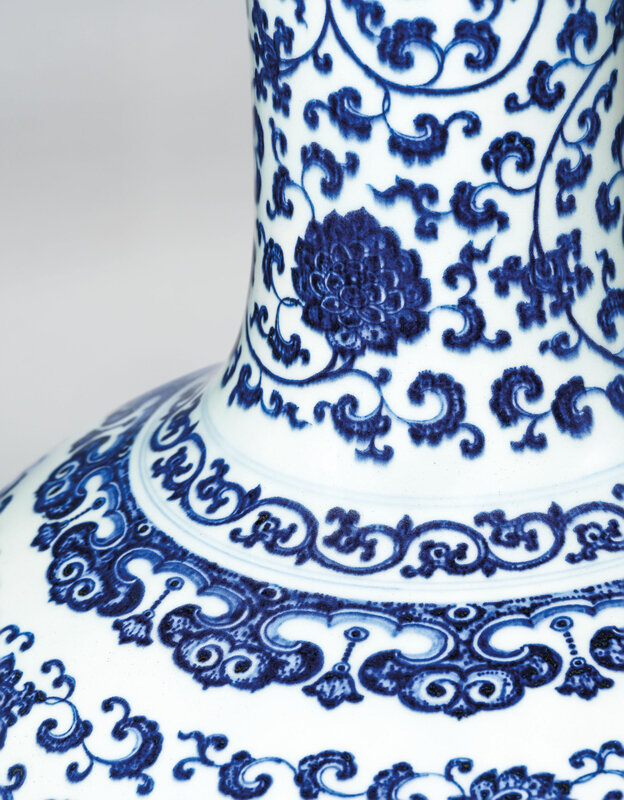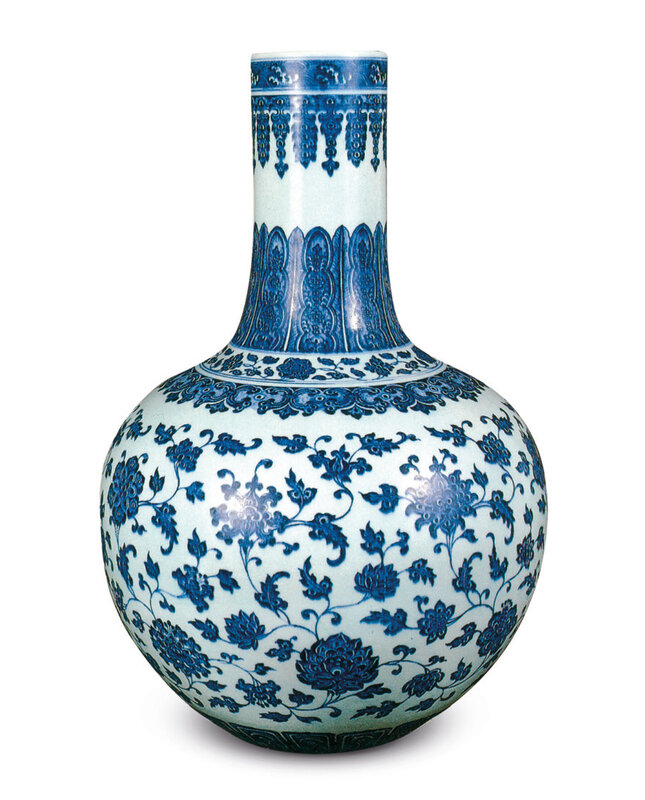A fine and exceptionally rare blue and white ‘lotus scroll’ vase, tianqiuping, Qianlong mark and period (1736-1795)
Lot 3109. A fine and exceptionally rare blue and white ‘lotus scroll’ vase, tianqiuping, Qianlong six-character seal mark in underglaze blue and of the period (1736-1795); 24 in. (61 cm.) high. Estimate HKD 7,000,000 - HKD 10,000,000. Price realised HKD 7,925,000. © Christie's Image Ltd 2019
The vase is superbly potted with a globular body rising to a cylindrical neck supported on a countersunk base, delicately painted in cobalt of rich, sapphire blue tones with an elaborate meandering lotus scroll on the neck and body, separated by a classic scroll and ruyi-head band on the shoulder. The mouth is decorated with a wave border, and the foot is encircled with a band of interlocking petal lappets. The base is inscribed with a Qianlong reign mark, wood box.
Provenance: Offered at Sotheby’s Hong Kong, 16 May 1977, lot 95.
Note: The form tianqiuping, also known as tianqiuzun, first appeared during the Yongle period, and was also made during the Xuande reign. The form is extremely difficult to fire but makes a remarkable visual impact, and thus became one of the most precious and highly desirable types of all the Ming and Qing imperial porcelain. It is interesting to note that even the Emperor Qianlong conveyed fondness for this magnificent form, as demonstrated by an entry dated to the 25th day of the 6th month of the 3rd year of Qianlong reign [1739], where the Emperor decreed an imperial order to Tang Ying, the superintendent of the Imperial kilns at Jingdezhen, to produce an ‘enlarged Xuande-style tianqiuping’.
The elaborate lotus meander design on the globular body and the band of upright petals above the foot also appear on a Qianlong blue and white tianqiuping in the Nanjing Museum, illustrated in The Official Kiln Porcelain of the Chinese Qing Dynasty, Shanghai, 2003, p. 232, (fig. 1). However the Nanjing example has a different decoration on the shoulders and neck, reflecting the variety of decorative repertoires available at the Imperial kilns at the time.
A blue and white tianqiuping, Qianlong mark and period (1736-1795), Nanjing Museum.
The Chinese word for ‘lotus’ shares a similar sound as the characters for ‘yearly’ and ‘honesty’, and thus conveys the meanings of perpetuality and integrity. Although the lotus design appears often on Qing porcelain, it is very rare to find it as the main motif on a tianqiuping.
Christie's. Important Chinese Ceramics and Works of Art, Hong Kong, 27 November 2019

/https%3A%2F%2Fprofilepics.canalblog.com%2Fprofilepics%2F1%2F0%2F100183.jpg)
/https%3A%2F%2Fstorage.canalblog.com%2F03%2F02%2F119589%2F96711876_o.jpg)
/https%3A%2F%2Fstorage.canalblog.com%2F11%2F31%2F119589%2F94773502_o.jpg)
/https%3A%2F%2Fstorage.canalblog.com%2F20%2F83%2F119589%2F94772815_o.jpg)
/https%3A%2F%2Fstorage.canalblog.com%2F26%2F72%2F119589%2F75604929_o.jpg)
/https%3A%2F%2Fstorage.canalblog.com%2F59%2F60%2F119589%2F26458628_o.jpg)







/image%2F1371349%2F20240416%2Fob_2a8420_437713933-1652609748842371-16764302136.jpg)
/image%2F1371349%2F20240414%2Fob_83ee65_2024-nyr-22642-0954-000-a-blue-and-whi.jpg)
/image%2F1371349%2F20240414%2Fob_15808c_2024-nyr-22642-0953-000-a-blue-and-whi.jpg)
/image%2F1371349%2F20240414%2Fob_e54295_2024-nyr-22642-0952-000-a-rare-blue-an.jpg)